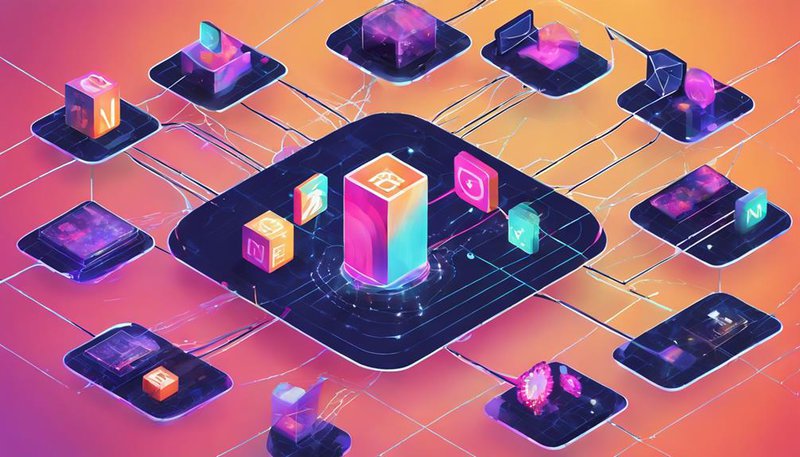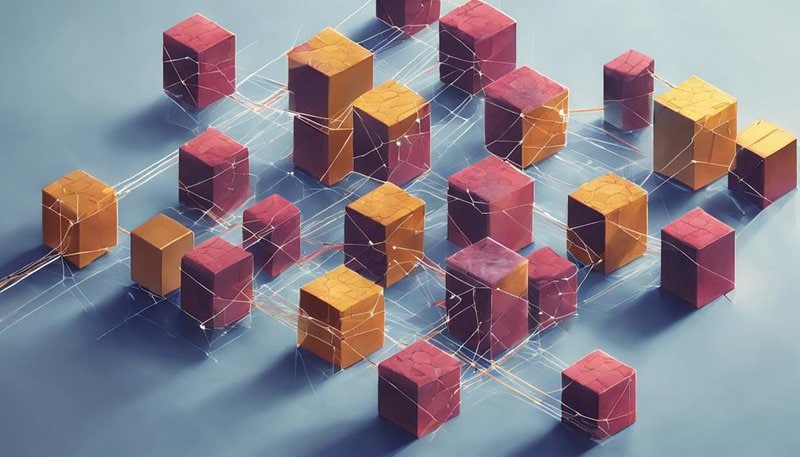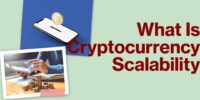How Blockchain Technology Powers NFTs

Blockchain technology powers NFTs by enabling secure and transparent ownership of digital assets through decentralized ledgers and smart contracts.
This innovative fusion of technology and creativity revolutionizes how we perceive authenticity and ownership in the digital realm, shaping the future of art and innovation.
Key Takeaways
- Decentralization enables true digital ownership.
- Immutable ledger secures NFT transactions.
- Smart contracts streamline secure NFT transactions.
- Data security assurance through blockchain technology.
The Basics of Blockchain Technology
Embrace the intricate web of interconnected blocks that form the foundation of blockchain technology. Within this distributed ledger, the essence of security resides. Consensus algorithms, the heartbeat of blockchain governance, ensure that every transaction is validated by the network. As you delve into the world of blockchain, remember that its security stems from the decentralized nature of its design.
Understanding consensus algorithms is key to comprehending the reliability of blockchain technology. These algorithms dictate how agreement is reached across the network, forging trust among participants. In the realm of blockchain security, this agreement ensures that the information stored within the blocks remains immutable and transparent.
When it comes to blockchain governance, the decentralized structure empowers every participant to have a say in the network's direction. By distributing control among many, rather than centralizing power, blockchain technology fosters a sense of collaboration and inclusivity. As you navigate this intricate landscape, remember that the essence of blockchain lies in its ability to serve the collective good.
Decentralization and NFTs
Unlock the power of decentralization as it intertwines with the captivating world of NFTs, revolutionizing digital ownership. Embracing decentralization in the realm of Non-Fungible Tokens (NFTs) brings forth a myriad of benefits that extend beyond traditional centralized systems. By leveraging decentralized networks, individuals like yourself have the opportunity to engage directly with creators, fostering a sense of community and collaboration.
Let's delve into the table below to gain a clearer understanding of how decentralization amplifies the NFT experience:
| Decentralization Benefits | Community Engagement Opportunities | Impact on NFT Ecosystem |
|---|---|---|
| Enhanced security and trust | Direct interaction with creators | Increased transparency |
| Elimination of intermediaries | Support for emerging artists | Empowerment of content creators |
| Ownership validation | Community-driven events | Diverse artistic representation |
These decentralization benefits not only empower you as a participant in the NFT space but also pave the way for a more inclusive and engaging ecosystem where creativity flourishes through community support.
Immutable Ledger for NFTs

Embrace the power of the immutable ledger when dealing with NFTs. Your data's security is assured, and transaction transparency is a significant benefit.
Let the blockchain's unalterable nature be your shield in the realm of digital ownership.
Data Security Assurance
With blockchain technology acting as an immutable ledger, data security assurance for NFTs is guaranteed. This innovative approach ensures that your digital assets are protected through robust measures like data encryption and network security. Consider the following to grasp the depth of security provided:
- Decentralized Consensus: Multiple nodes validate transactions, making it nearly impossible for malicious actors to alter data.
- Tamper-Proof Records: Each block in the chain is linked cryptographically, creating a secure and unchangeable record.
- Transparent Access Control: Permissioned access ensures that only authorized parties can interact with the data.
- Immutability: Once data is recorded on the blockchain, it can't be altered, enhancing the security and authenticity of your NFTs.
- Resilience to Cyber Threats: The distributed nature of blockchain technology makes it highly resistant to cyberattacks, safeguarding your valuable digital assets.
Transaction Transparency Benefit
How does the immutable ledger provided by blockchain technology enhance the transaction transparency benefit for NFTs? By leveraging blockchain's transparent nature, NFT transactions benefit from unparalleled traceability and security. This transparency offers significant advantages, such as fraud prevention and trust-building among parties involved in NFT transactions. Each transaction is permanently recorded on the blockchain, creating an auditable trail that ensures authenticity and ownership. This not only verifies the legitimacy of NFTs but also instills confidence in buyers and sellers. Through traceable transactions, blockchain technology acts as a guardian, safeguarding the integrity of NFT dealings. Embracing this transparency is key to fostering a trustworthy environment within the NFT ecosystem.
| Transparency Advantages | Fraud Prevention | Trust Building |
|---|---|---|
| Auditable Transaction Record | Enhanced Security Measures | Confidence Boost |
| Immutable Ledger | Fraud Detection Mechanisms | Authenticity Verification |
| Traceable Ownership | Anti-counterfeiting Measures | Establishing Credibility |
Smart Contracts and NFTs
Embrace the power of smart contracts in the realm of NFTs; these digital agreements ensure secure transactions and streamline ownership verification processes.
With smart contracts, you can trust in the integrity of your NFT dealings, as they're executed automatically, without the need for intermediaries.
Let the efficiency and transparency of blockchain-backed smart contracts redefine how you engage with the world of non-fungible tokens.
Secure NFT Transactions
Leveraging smart contracts, NFTs ensure secure transactions in the digital realm by prioritizing privacy protection and identity verification. Here are five key elements that paint a vivid picture of how NFTs achieve this:
- Immutable Records: Each transaction is permanently recorded on the blockchain, ensuring transparency and security.
- Decentralized Verification: Identity verification is decentralized, reducing the risk of fraud.
- Encryption Technologies: Cutting-edge encryption methods safeguard sensitive information.
- Smart Contract Automation: Transactions are executed automatically when predetermined conditions are met.
- Secure Wallet Integration: Integration with secure wallets adds an extra layer of protection for digital assets.
Automated Ownership Verification
Automated ownership verification through smart contracts and NFTs streamlines and secures digital asset transactions with unparalleled efficiency. This innovative approach simplifies the ownership validation process, offering benefits such as real-time verification, transparency, and immutability.
By automating the verification of ownership rights, smart contracts eliminate the need for intermediaries, reducing costs and increasing trust among parties. Through the use of blockchain technology, every step of the ownership validation process is recorded and can't be altered, ensuring a secure and reliable transaction environment.
Embracing automated verification benefits not only enhances the speed of transactions but also safeguards the authenticity of digital assets, ultimately revolutionizing the way ownership is validated in the digital realm.
Interoperability in NFT Ecosystem

In the vibrant world of NFTs, the seamless interoperability among different platforms and blockchains is becoming increasingly essential for the continued growth and evolution of this innovative ecosystem. As you navigate this intricate landscape, envision a realm where:
- Cross-chain interoperability opens doors to new possibilities, allowing assets to flow freely between diverse blockchain networks.
- NFT standards harmonize the varied technical specifications across platforms, fostering a unified environment for creators and collectors alike.
- Interoperable NFT marketplaces serve as bustling hubs where unique digital assets can be discovered, traded, and showcased seamlessly.
- Cross-chain compatibility bridges the gap between different blockchain protocols, enabling a more cohesive experience for all participants.
- Collaborative efforts drive the development of interoperability solutions, propelling the NFT ecosystem towards a future defined by fluid connectivity and boundless creativity.
Embrace the interconnected nature of this evolving landscape, where interoperability acts as the cornerstone of progress, uniting disparate elements into a harmonious symphony of innovation and possibility.
Tokenization of Digital Assets
Embarking on the journey of tokenizing digital assets unveils a realm where value transcends physical boundaries, unlocking a new era of digital ownership and exchange. Through asset tokenization, you enter a domain where the intangible becomes tangible, where the ownership of digital assets is no longer a mere concept but a reality. This transformation allows for the fractional ownership of high-value assets, enabling individuals to invest in assets that were once out of reach. By breaking down assets into digital tokens, the barriers to entry are dismantled, democratizing investment opportunities for all.
To provide a clearer perspective, let's delve into a table showcasing the benefits of asset tokenization:
| Benefits of Asset Tokenization |
|---|
| Fractional Ownership |
| Increased Liquidity |
| Enhanced Transparency |
| Global Accessibility |
In this new landscape, digital ownership takes center stage, empowering individuals to engage in the economy of the future with newfound accessibility and inclusivity.
Blockchain Scalability Solutions

To overcome the challenges of scalability in blockchain technology, consider implementing innovative solutions that enhance network efficiency and performance. When addressing blockchain scalability solutions, factors such as transaction speed and network congestion play crucial roles in ensuring a seamless experience for users.
Here are five key strategies to enhance blockchain scalability:
- Off-chain Scaling Solutions: Implementing techniques like state channels or sidechains can significantly increase transaction throughput.
- Sharding: Dividing the blockchain into smaller partitions called shards can improve network performance by processing transactions in parallel.
- Layer 2 Solutions**: Utilizing Layer 2 protocols like Lightning Network or Plasma can help alleviate congestion on the main blockchain.
- Consensus Mechanism Optimization: Exploring consensus algorithms such as Proof of Stake (PoS) or Delegated Proof of Stake (DPoS) can enhance transaction processing speeds.
- Data Compression Techniques**: Employing innovative data compression methods can reduce the size of transactions, thereby boosting network efficiency.
NFT Ownership Verification
Discover the intricate process of verifying ownership of NFTs to delve deeper into the world of digital assets. When it comes to NFT ownership verification, two critical elements play a significant role: identity authentication and proof of ownership. Identity authentication ensures that the individual claiming ownership is indeed the rightful owner, while proof of ownership establishes the unique digital fingerprint that distinguishes one NFT from another.
To grasp this concept better, consider the following table that outlines the steps involved in NFT ownership verification:
| Step | Description |
|---|---|
| Identity Verification | Confirming the user's identity through secure methods. |
| Ownership Proof | Providing cryptographic proof of ownership. |
| Blockchain Record | Updating the blockchain with ownership details. |
Environmental Impact of NFTs

Considering the ever-growing concerns surrounding sustainability and ecological impact, it's imperative to evaluate the environmental footprint of NFTs in the digital realm. When delving into the realm of NFTs, it's essential to recognize the impact they have on the environment.
Here are some key points to consider:
- Energy Consumption: The process of minting and trading NFTs often requires significant energy consumption, contributing to a substantial carbon footprint.
- Carbon Footprint: The carbon emissions associated with blockchain transactions and NFT activities raise concerns about their environmental sustainability.
- Sustainability: Embracing sustainable practices within the NFT ecosystem is crucial for minimizing the environmental impact and fostering eco-friendly initiatives.
- Eco-Friendly Initiatives: Exploring ways to offset carbon emissions, promote renewable energy use, and implement green solutions are vital steps towards making NFTs more environmentally friendly.
- Responsible Consumption: Encouraging responsible consumption habits among NFT creators and collectors can help mitigate the environmental consequences associated with these digital assets.
Future Trends in NFT Development
As you journey into the realm of future trends in NFT development, behold the emergence of groundbreaking technologies that will reshape the landscape of digital ownership.
Witness the fusion of artistic minds in collaborative NFT projects, forging new paths for creators and collectors alike.
Embrace the innovative spirit driving the evolution of NFTs, where creativity meets technology in a harmonious dance of possibilities.
Emerging NFT Technologies
The evolution of NFT technologies promises a dynamic future of innovation and creativity in the digital realm. As you delve into the emerging trends shaping the NFT landscape, consider these glimpses into what lies ahead:
- Interoperability: Seamless interaction between different NFT platforms.
- Scalability Solutions: Enhancements to handle increased transactions efficiently.
- Fractional Ownership: Enabling shared ownership of high-value assets.
- Environmental Sustainability: Focus on eco-friendly NFT creation methods.
- Augmented Reality Integration: Immersive experiences blending physical and digital worlds.
Embrace these developments with anticipation, for they pave the path toward a more interconnected and sustainable NFT ecosystem that thrives on inclusivity and innovation.
Artistic Collaborations in NFTs
In the realm of NFT development, the harmonious fusion of artistic talents through collaborative endeavors is poised to ignite a new era of creative brilliance and interconnected expression. Creative partnerships and artistic crossovers are paving the way for innovative collaborative creations in the NFT space, resulting in unique collectibles that transcend individual boundaries. These partnerships not only showcase the combined skills of talented artists but also offer collectors a glimpse into the synergy that arises when creative minds unite. By embracing collaborative efforts, artists can push the boundaries of traditional art forms and bring forth a new wave of artistic innovation that captivates audiences worldwide. The future of NFTs lies in these artistic collaborations, where the power of unity propels creativity to unprecedented heights.
| Creative Partnerships | Artistic Crossovers | Unique Collectibles |
|---|---|---|
| Individual talents merging | Diverse art styles blending | Exclusive digital artworks |
| Collaborative spirit | Fusion of creative visions | Limited edition NFTs |
| Innovative creations | Synergy of artistic expressions | Rare and valuable assets |
| Shared expertise | Intersection of genres | One-of-a-kind digital art pieces |
| Collective genius | Harmonious artistic fusion | Highly sought-after NFTs |
Frequently Asked Questions
How Do NFTs Impact the Art Market and Traditional Art Industry?
In the art market and traditional industry, NFTs revolutionize valuation by granting digital assets scarcity and authenticity. They empower artists to reach wider audiences, disrupting conventional norms and fostering creativity with limitless possibilities.
Can NFTs Be Used for More Than Just Digital Art, Such as Music or Collectibles?
Yes, NFTs can revolutionize various industries beyond art. Embrace the future where music royalties are transparently tracked and sports memorabilia ownership is authenticated seamlessly. Explore the limitless possibilities that blockchain technology offers.
Are There Any Potential Legal Challenges or Copyright Issues Related to NFT Ownership?
When it comes to NFT ownership, legal implications and copyright issues are significant considerations. Understanding the complexities of intellectual property rights, licensing agreements, and digital ownership is crucial to navigating the evolving landscape of NFTs.
How Can Individuals Protect Their NFT Investments From Theft or Fraud?
To protect your NFT investments, implement robust security measures and authentication methods. Consider insurance options for added protection. Embrace risk management strategies to safeguard your digital assets from potential theft or fraud. Stay vigilant and proactive.
What Role Do Marketplaces and Platforms Play in the Buying, Selling, and Trading of Nfts?
In the realm of NFTs, marketplace dynamics dictate the flow of buying, selling, and trading. Understand platform regulations to navigate this digital landscape wisely. Your choices impact the market; choose with care and intention.








